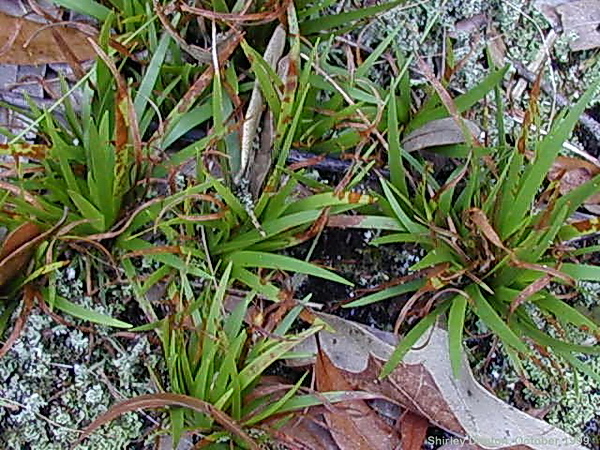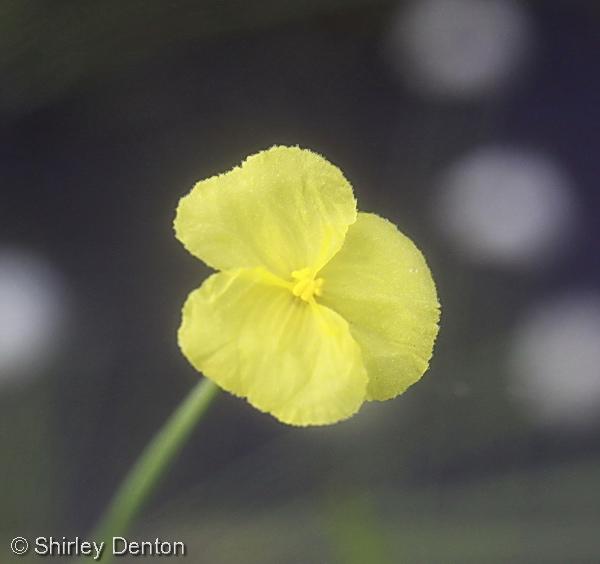Difference between revisions of "Xyris brevifolia"
(→Photo Gallery) |
|||
| Line 45: | Line 45: | ||
===Use by animals=== <!--Herbivory, granivory, insect hosting, etc.--> | ===Use by animals=== <!--Herbivory, granivory, insect hosting, etc.--> | ||
| + | The Florida Grasshopper Sparrow nest material are made up of grasses and grass-like monocots, such as ''Xyris elliottii''. Other plant species used in making the nests include wiregrass and bluestems<ref name=”Delany1998”> Delany, Michael F. and Stephen B. Linda (1998). “Characteristics of Florida Grasshopper Sparrow Nests.” The Wilson Bulletin Vol. 110, No. 1: 136-139. </ref>. | ||
| + | |||
===Diseases and parasites=== | ===Diseases and parasites=== | ||
==Conservation and Management== | ==Conservation and Management== | ||
Revision as of 18:54, 15 March 2016
| Xyris brevifolia | |
|---|---|

| |
| Photo by Shirley Denton (Copyrighted, use by photographer’s permission only), Nature Photography by Shirley Denton | |
| Scientific classification | |
| Kingdom: | Plantae |
| Division: | Magnoliophyta - Flowering plants |
| Class: | Liliopsida – Monocotyledons |
| Order: | Commelinales |
| Family: | Xyridaceae |
| Genus: | Xyris |
| Species: | X. brevifolia |
| Binomial name | |
| Xyris brevifolia Michx. | |

| |
| Natural range of Xyris brevifolia from USDA NRCS Plants Database. | |
Common name: shortleaf yelloweyed grass
Contents
Taxonomic notes
Description
A description of Xyris brevifolia is provided in The Flora of North America.
Distribution
Ecology
Habitat
In the Coastal Plain in Florida, Xyris brevifolia can occur in cypress depression swamps, coastal mesic flatwoods, wet pine flatwoods, river floodplains, Magnolia virginiana-Persea-Nyssa hammocks, exposed shores of karst ponds, cabbage palm hammock margins, tropical hammocks, coastal swales, and seepage bogs. It has occurred in disturbed areas such as roadside depressions and bulldozed clearing in pine-palmetto flatwoods (FSU Herbarium). Soils include Mandarin (Typic Haplohumods), loamy soil, loamy sand, sandy peat, and Newnan (Ultic Haplohumods) (FSU Herbarium). Associated species include Pinus palustris, Aristida stricta, Serenoa repens, Ilex glabra, Xyris caroliniana, X. ambigua, Rhychospora plumosa, R. fernaldii, Lachnocaulon, Euphorbia telephiodes, and Drosera intermedia (FSU Herbarium).
Phenology
Flowers and fruits February through October (FSU Herbarium).
Seed dispersal
Seed bank and germination
Fire ecology
X. brevifolia has been observed growing in recently burned mesic pine flatwoods (FSU Herbarium).
Pollination
The following Hymenoptera families and species were observed visiting flowers of Xyris brevifolia at Archbold Biological Station (Deyrup 2015):
Halictidae: Lasioglossum pectoralis, L. tamiamensis
Megachilidae: Megachile brevis pseudobrevis
Use by animals
The Florida Grasshopper Sparrow nest material are made up of grasses and grass-like monocots, such as Xyris elliottii. Other plant species used in making the nests include wiregrass and bluestems[1].
Diseases and parasites
Conservation and Management
Cultivation and restoration
Photo Gallery
Flower of Xyris brevifolia Photo by Shirley Denton (Copyrighted, use by photographer’s permission only), Nature Photography by Shirley Denton
References and notes
Deyrup, M.A. and N.D. 2015. Database of observations of Hymenoptera visitations to flowers of plants on Archbold Biological Station, Florida, USA.
Florida State University Robert K. Godfrey Herbarium database. URL: http://herbarium.bio.fsu.edu. Last accessed: November 2015. Collectors: Mary Atkinson, Loran C. Anderson, Edwin L. Bridges, George R. Cooley, A.H. Curtiss, Richard J. Eaton, Bob Fewster, Robert K. Godfrey, E.M. Hodgson, Richard D. Houk, Ann F. Johnson, Lisa Keppner, Mabel Kral, Robert Kral, O. Lakela, Sidney McDaniel, Marc Minno, Joseph Monachino, Steve L. Orzell, Paul O. Schallert, Cecil R. Slaughter, Robert F. Thorne, D.B. Ward, S.S. Ward. States and Counties: Florida: Alachua, Baker, Bay, Bradford, Citrus, Clay, Collier, Columbia, Dixie, Flagler, Franklin, Hamilton, Highlands, Hillsborough, Indian River, Lee, Leon, Levy, Liberty, Okeechobee, Osceola, Pinellas, Santa Rosa, Sarasota, Seminole, Sumter, Volusia, Wakulla, Walton, Washington. Compiled by Tall Timbers Research Station and Land Conservancy.
- ↑ Delany, Michael F. and Stephen B. Linda (1998). “Characteristics of Florida Grasshopper Sparrow Nests.” The Wilson Bulletin Vol. 110, No. 1: 136-139.
